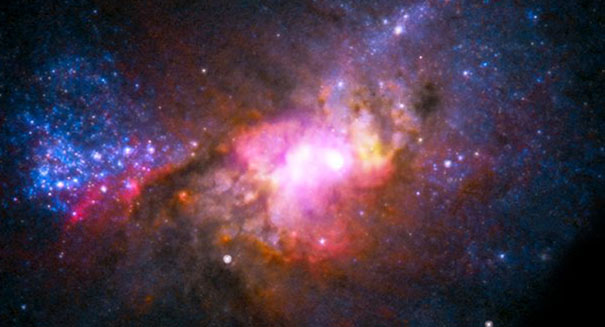
New telescope capabilities pave the way for more detailed cosmic observation.
Researchers from the National Radio Astronomy Laboratory (NRAO) have revealed never before seen images of nearby starburst galaxy M82. These new data highlight streamers of material fleeing the disk of the galaxy as well as concentrations of dense molecular gas surrounding pockets of intense star formation. Previously, these kinds of observations have not been easy since molecules that are used to map the distribution of dense gas, like HCN (hydrogen cyanide) and HCO+ (formylium), shine feebly in millimeter light.
According to the Wikipedia entry, A starburst galaxy is a galaxy undergoing an exceptionally high rate of star formation, as compared to the long-term average rate of star formation in the galaxy or the star formation rate observed in most other galaxies. In a starburst galaxy, the rate of star formation is so large that the galaxy will consume all of its gas reservoir, from which the stars are forming, on a timescale much shorter than the age of the galaxy. As such, the starburst nature of a galaxy is a phase, and one that typically occupies a brief period of a galaxy’s evolution.
M82, which is located approximately 12 million light-years away in the constellation Ursa Major, is a classic example of a starburst galaxy — one that is producing new stars tens- to hundreds-of-times faster than our own Milky Way. Its relatively nearby location made it an ideal target for the Robert C. Byrd Green Bank Telescope (GBT)‘s newly equipped “W-Band” receiver, which is capable of detecting the millimeter wavelength light that is emitted by molecular gas. This new capability makes the GBT the world’s largest single-dish, millimeter-wave telescope. With its new W-Band receiver, the GBT was able to make highly sensitive, wide-angle images of the gases in and around M82.
“With this new vision, we were able to look at M82 to explore how the distribution of molecular gas in the galaxy corresponded to areas of intense star formation,” said Amanda Kepley, a post-doctoral fellow at the NRAO in Green Bank, West Virginia, and lead author on a paper accepted for publication in the Astrophysical Journal Letters.
“The GBT data clearly show billowing concentrations of dense molecular gas huddled around areas that are undergoing bursts of intense star formation,” said Kepley. “They also reveal giant outflows of ionized gas fleeing the disk of the galaxy. These outflows are driven by star formation deep within the galaxy.”
Astronomers hope that the new capabilities will allow them to observe galaxies (and parts within galaxies) much more quickly.
“Having this new capability may help us understand why stars form where they do,” said Kepley.
Leave a Reply